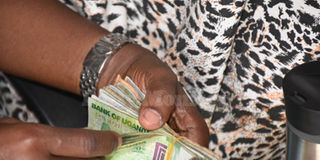Public debt grows by Shs4.47 trillion

Government has been borrowing heavily to mitigate Covid-19 related disruptions, espcially on business and employment as well as propping up capacity of the health sector. PHOTO | EDGAR R BATTE
What you need to know:
- Between June 2020 and June 2021, according to Bank of Uganda, the stock of public debt grew from Shs65.8 trillion to Shs70.3 trillion, representing an increase of 22.5 per cent.
The stock of public debt has increased to Shs70.3 trillion, indicating a growth of 22.5 per cent as of June 2021.
In details contained in the Monetary Policy Report for the period ended August, Bank of Uganda said the stock of public debt had grown from Shs65.83 trillion ($17.96b) as of June 2020 to Shs70.3 trillion, which represents an increase of Shs4.47 trillion in just one year.
The increase, Bank of Uganda said, had during the period, pushed the nominal debt ratio to gross domestic product to 46.3 per cent up from 41 per cent by June 2020.
Uganda’s public debt has been growing rapidly from 35.3 per cent by June 2019, to the current levels and is projected to grow further to 51.9 per cent by the end of the 2021/22 financial year.
The increase between June 2020 and June 2021, according to Bank of Uganda, was mainly due to significant spending pressures resulting from Covid-19 disruptions, which presented major risks in the form of a rapidly growing cost of financing.
According to data from the Central Bank, debt service to domestic revenue ratio has been steadily rising, growing to 24.6 per cent by June, up from 22.4 per cent and 21.7 per cent in June 2019 and June 2020, respectively.
Government recently acquired a $1b loan from the International Monetary Fund (IMF) that is expected to support post Covid-19 recovery and lend support to implementation of the third National Development Plan.
The money, which is also expected to moderate further growth of public debt is likely to increase the stock of public debt before the close of the 2021/22 financial year.
Recently, Finance Minister Matia Kasaija conceded that public debt had grown to worrying levels, noting that borrowing had reached levels that had started making government uncomfortable.
“Once you see you have gone beyond 50 per cent, it requires one to be concerned. So we are conscious and extremely concerned about our public debt,” he said, noting that money to handle crises such as Covid-19 would be mobilised through budget cuts, especially to non-essential services such as travel, conferences and accommodation, among others.
Public debt has been growing against a weak position of revenue performance, which during the 2021/22 financial year is expected to underperform by Shs1.836 trillion due to resurgence in Covid-19 cases and related disruptions such lockdown of the economy.
During the 2021/22 financial year, government is projected to spend Shs34.2 trillion, which is 6.4 per cent lower than what had been planned during the previous financial year.
According to the Quarterly Debt Statistical Bulletin released last week, the Ministry of Finance noted that the stock of public debt had increased to $18.14b for the period ended March from $17.96b as of December 2020.
Out of $18.14b, 36.1 per cent, which represents $6.54b (Shs23.97 trillion) was domestic debt while external debt constituted 63.9 per cent, which translates to $11.59b (Shs42.48 trillion).
Source of public debt
According to the Ministry of Finance the largest source of Uganda’s credit for the period ended March remained multilateral lenders, which contributed 62.7 per cent or $7.27b while bilateral lenders accounted for 29.9 per cent ($3.47b). Commercial banks contributed 7.4 per cent or $0.85b.
Multilateral debt is dominated by International Development Association, the lending arm of the World Bank, which has a share of 58.1 per cent or $7.3b and African Development Fund with a share of 19.6 per cent or $1.4b.
Bilateral debt is dominated by Exim Bank of China, which has a share of 73.2 per cent or $2.5b while Japan has a share of 8.5 per cent or $0.3b.
Private and commercial loans are dominated by Trade and Development Bank, which holds at least 41.3 per cent or $ 0.4b.




